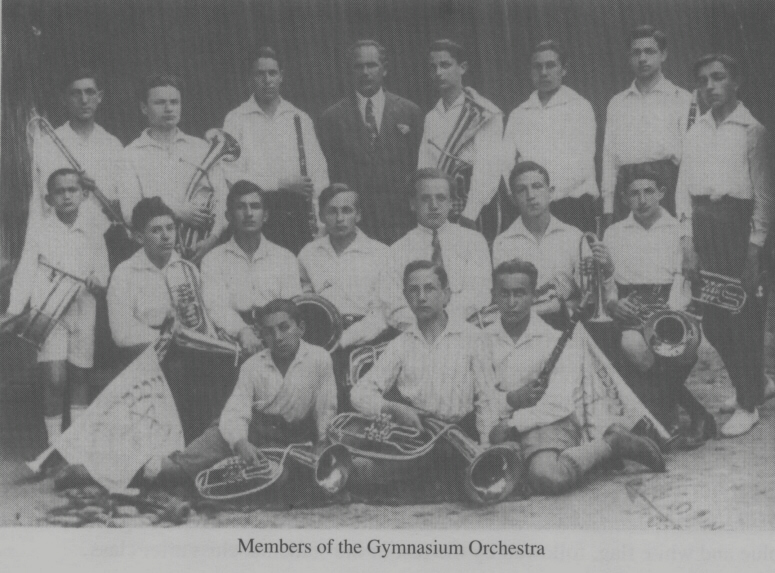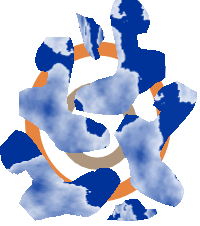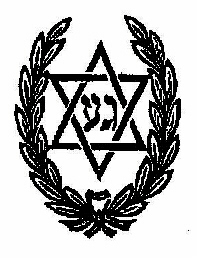Page 27
The Hebrew Gymnasium, whose earlier name was "Tarbut College", opened
on 9 November 1919, 16 Marcheshvan 5680, in the "Zion People's House".
(The "Tarbut" network, founded by the "Association of Lovers of the
Ancient Language", was set up in Russia in 1917, and moved to Poland
after the Soviet government changed the language of instruction of its
institutions to Yiddish. For some time, its schools were under the
patronage of the Board of Educators of the Zionist Centre in Warsaw,
and in 1919 it came under the patronage of the Bureau of Education and
Culture of the Zionist Organisation in Poland.
The Hebrew schools of
Vilna, Bialystok and Rovno were under the patronage of district
committees). In the "Jubilee Gazette", which was published in 1924 to
commemorate the founding of the Gymnasium five years earlier, the
introductory article, signed by "The School Board", contains the
following passage: "The School must give our children a complete and
full education to change the painful situation where our sons have
either heard nothing about our own history, or have heard things they
had better not hear at all...our School has to be, and is bound to be,
humanist, and the content of its programme of studies must be Hebraic.
The schools our children have attended have changed their language of
instruction several times. The conclusion we have drawn from this is
that the language of instruction of our school need not be dependent on
the current political situation. The language of the New Jewish
School, which allots so important a place to the works created by
Hebrew culture, cannot be anything but the Eternal Language of Jewish
Culture, which is, moreover, the language of our new life".

Yaacov, son of Lipa Patt, testifies: "Founding the Gymnasium was part
of Eastern European Jewry's struggle for cultural autonomy. It was a
twofold struggle, externally against the oppressive policy of the
hostile Polish regime, and internally, in the Jewish population
centers, against the trend which attempted to impose Yiddish on the
Jewish populace and its institutions of learning. Poland, which at
that time had regained its independence, had officially undertaken to
preserve the rights of the Jews, and the need was felt to confront her
with a fait accompli, the establishment of a network of Hebrew schools.
At that time Hebrew education and Yiddish education were in
competition".
To Joseph Serlin, who
was then a thirteen year old boy, the founding of the Gymnasium was a
kind of personal message of redemption. He was a student of a Hebrew
elementary school, "The Second Common People's School" on Lipova
Street, and one day the principal of his school announced: "From
today, our language of instruction will be Yiddish". "We don't agree,"
declared Joseph, and he spoke to his friends and organized a strike.
The strikers held out and did not come to class for no more than three
days and then they all caved in, except for two students. One of them
was the boy Joseph. The principal expelled him from school for being a
troublemaker. "I left, and didn't know what to tell my father", said
former Israeli Minister of Health Joseph Serlin fifty years later. "As
I was walking home I noticed advertisements: 'A Hebrew Gymnasium has
been founded. Students are invited to register'. Without asking my
father, I went to the 'People's House' and registered. When I told my
father everything, he did not reprimand me, but gave me a kiss".
The
advertisements said that students who wished to be accepted first had
to pass entrance examinations. Yona Kaplan, the son of one of the
founders, related: "I failed the examination in Russian. Fortunately,
I successfully passed the examinations in the other subjects, and was
accepted". The parents of Eliezer Avinoam (Lipkind), aged thirteen,
intended to enrol him in the Polish Gymnasium, so that he would "become
a decent human being", that is to say, holder of a certificate of
matriculation issued by the State. "My brother Reuben did not (p.29)
agree", related Eliezer Avinoam many years later. Reuben, who attended
a Polish Gymnasium, was born too early, and in the new Gymnasium there
was no class for seventeen year old students; he did not want his
brother to suffer the way he had suffered, and so "he did not rest
until he had convinced our parents that my place was in the Hebrew
Gymnasium. I received a Hebrew education, was a member of the Zionist
Youth Movement, worked at a Training Farm (Hachsharah), emigrated to
Israel, and stayed alive thanks to him. Blessed be his memory", wrote
Avinoam. His brother Reuben remained in Poland and died in the
Holocaust.
The financial difficulties were not too
numerous, testified Rachel Kreisman, the daughter of Eliezer Kahana.
The Board of Directors took care of the initial expenses themselves.
For several months, the Gymnasium was housed in the "People's House",
afterwards it became necessary to move. A.S.Hershberg wrote: "The
Authorities would not allow any teaching activities to take place on
the premises of a political party. Having no other choice, the school
rented an apartment at 74, Sienkiewitz Street, which had earlier been
used by the Hebrew Elementary School". In the first year, the
Gymnasium had 174 students, a hundred boys and seventy-four girls.
They studied in three preparatory classes and three ordinary classes.
The first teachers came from Galicia. The first principal of the
school, Eliezer Furman (Karari) relates: "My teacher, Rabbi Prof.
Moshe Shor, persuaded me to travel from Lvov to Bialystok, and to set
up the Hebrew Gymnasium there. I went there, studied the conditions,
met the people, and returned to Lvov. I hired teachers, and together
we came to Bialystok and opened the Gymnasium in 1919". The teacher
Aharonowitz (whom the students nicknamed "Kaykele") wrote in the
Jubilee Gazette commemorating the fifth anniversary of the founding of
the school: "In that difficult period when the Hebrew school was being
created, the cultural activists realized that without a full complement
of teachers having both a Jewish and a European education, a Hebrew
school could not exist and had no future. Such people could only be
found in Galicia, because early in the Enlightenment period in Russia
our brethren did not have access to higher general and (p.30) Hebrew
education. Galicia supplied a group of young, nationalist minded
enthusiasts who set up, developed, and perfected Hebrew schools from
top to bottom".
The complement of teachers who came from Galicia to
Bialystok included Chaim Zweigel, Milgrom, Issachar Reiss and I.
Krulik. In the early years teachers changed at frequent intervals,
because not all of them had teaching skills, or were deserving of the
task they had to perform. Yaacov Samid (Semiatitzky), who entered
Class 1 in 1921, remembers the English teacher who taught Class 2. He
was a businessman who had a good command of the English language, but
knew nothing about educational theory and the methodology of
instruction. During English lessons, he used to walk about in the
classroom muttering to himself and doing calculations of profit and
loss... After some years, the staff stabilized and consolidated, and
the good teachers remained. "The principal, Dr. Furman, taught us
Physics", relates former student Dr. Eliezer Remen. "There were no
textbooks, and we would write down what he said in our exercise books.
I have kept the exercise books to this very day". Similarly, Nathanel
Katz remembers: "We were continually hunched over our desks, and our
pens, which were not of the best quality, would dry up from time to
time. Using hard pencils, we kept filling our exercise books with
notes, notes, and more notes.... We wrote down the whole of world
history, starting from the Middle Ages through to the Modern Age. We
were very busy". Katz testified, moreover, that the teachers spoke
"excellent Polish and the Hebrew of Abba Eban". The first principal of
the Bialystok Gymnasium was not able to keep his job for more than a
year. Late in July, 1920, the Red Army invaded the Bialystok district,
and held it for less than a month. Within this short period of time,
the "Workers' Representatives" managed to confiscate all goods
manufactured in the town, the supplies stocked in the shops, and the
assets of the Jewish community.
On August 22, the Polish Army
reconquered the area, but they certainly did not come to the rescue of
the Jewish population: General Haller's men attacked the Jews and
ransacked their homes. "The Bolshevik rule in the town would have
destroyed the Gymnasium if the members of the Jewish community and our
students had not risked their lives to save the property of the
school," reported David Braver in the Jubilee Gazette four years later.
As soon as the Bolveshiks pulled out, the school re-opened. Though the
number of new students was small, virtually all the students from the
previous year returned. Furman-Karari was succeeded by Chaim Zweigel,
who later changed his name to Zalzali, and then to Sarig. He, too, was
unable to hold the job for more than a year, and later left Bialystok
to take up a new post as principal at the Teachers Seminary in Vilna,
but he kept in touch with the students and the teachers of the
Gymnasium. This is evidenced by his letters, which were published in
the magazine "Anachnu" ("We") in 1923. Zweigel went to Israel, and
became the principal of the Teachers Seminary at Givat Ha'Shloshah.
Two other principals served for short periods: Dr. Eliyahu Rosenbaum
(1921-1922), who Hebraized his name to Meroz and served as Director of
the Department of Education of the Tel-Aviv Municipality, and Dr.
David Rosenmann (1922-1923).
|





